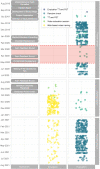Pilot study of an interprofessional pediatric mechanical ventilation educational initiative in two intensive care units
- PMID: 37641053
- PMCID: PMC10463469
- DOI: 10.1186/s12909-023-04599-1
Pilot study of an interprofessional pediatric mechanical ventilation educational initiative in two intensive care units
Abstract
Introduction: Inappropriate ventilator settings, non-adherence to a lung-protective ventilation strategy, and inadequate patient monitoring during mechanical ventilation can potentially expose critically ill children to additional risks. We set out to improve team theoretical knowledge and practical skills regarding pediatric mechanical ventilation and to increase compliance with treatment goals.
Methods: An educational initiative was conducted from August 2019 to July 2021 in a neonatal and pediatric intensive care unit of the University Children's Hospital, Hamburg-Eppendorf, Germany. We tested baseline theoretical knowledge using a multiple choice theory test (TT) and practical skills using a practical skill test (PST), consisting of four sequential Objective Structured Clinical Examinations of physicians and nurses. We then implemented an educational bundle that included video self-training, checklists, pocket cards, and reevaluated team performance. Ventilators and monitor settings were randomly checked in all ventilated patients. We used a process control chart and a mixed-effects model to analyze the primary outcome.
Results: A total of 47 nurses and 20 physicians underwent assessment both before and after the implementation of the initiative using TT. Additionally, 34 nurses and 20 physicians were evaluated using the PST component of the initiative. The findings revealed a significant improvement in staff performance for both TT and PST (TT: 80% [confidence interval (CI): 77.2-82.9] vs. 86% [CI: 83.1-88.0]; PST: 73% [CI: 69.7-75.5] vs. 95% [CI: 93.8-97.1]). Additionally, there was a notable increase in self-confidence among participants, and compliance with mechanical ventilation treatment goals also saw a substantial rise, increasing from 87.8% to 94.5%.
Discussion: Implementing a pediatric mechanical ventilation education bundle improved theoretical knowledge and practical skills among interprofessional pediatric intensive care staff and increased treatment goal compliance in ventilated children.
Keywords: Checklists; Educational film; Educational initiative; Selfconfidence; Team performance; Treatment goal compliance.
© 2023. BioMed Central Ltd., part of Springer Nature.
Conflict of interest statement
The authors declare no competing interests.
Figures




References
-
- Brower RG, Lanken PN, MacIntyre N, Matthay MA, Morris A, Ancukiewicz M, Schoenfeld D, Thompson BT, National Heart L, Blood Institute ACTN. Higher versus lower positive end-expiratory pressures in patients with the acute respiratory distress syndrome. N Engl J Med. 2004;351(4):327–336. doi: 10.1056/NEJMoa032193. - DOI - PubMed
MeSH terms
Grants and funding
- HANSE Förderpreis/Wissenschaftlicher Verein zur Förderung der klinisch angewendeten Forschung in der Intensivmedizin e.V. (WIVIM), Bremen, Germany
- HANSE Förderpreis/Wissenschaftlicher Verein zur Förderung der klinisch angewendeten Forschung in der Intensivmedizin e.V. (WIVIM), Bremen, Germany
- HANSE Förderpreis/Wissenschaftlicher Verein zur Förderung der klinisch angewendeten Forschung in der Intensivmedizin e.V. (WIVIM), Bremen, Germany
LinkOut - more resources
Full Text Sources

